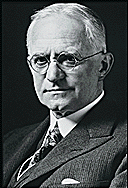
Photography In the 1920s

George Eastman (above) helped popularize the medium of photography during the 1920s.
During chapter 2, a main theme was the photography of Mr. McKee. His photographs were bleak examples of the medium, perhaps a result of the great popularization of photography during this decade. This page will explain what was happening in the world of photography during the 1920s.
During
the early parts of the twentieth century until the 1920s the medium of
photography was searching for widespread popular acceptance. The production of more portable cameras by companies such as
Eastman Kodak allowed almost anyone with an interest to become a photographer.
This phenomenon seems to be descried in chapter two of The Great
Gatsby in the character of Chester McKee.
A self-described artist and photographer, he bores Nick with descriptions
of his works on the subjects of Long Island and his wife.
During this chapter, there are extensive discussions of photography at
Myrtle’s apartment. Nick seems to
think his photography is terrible, describing his portrait of George Wilson’s
mother as an “ectoplasm on the wall.” He
also mocks Mrs. Lucille McKee for her vanity when she mentions “that her
husband had photographed her a hundred and twenty-seven times since they had
been married.” Nick’s views
probably constituted the popular view of photography during the firs few decades
of the twentieth century, before photography was viewed as a true art form
thanks to the work of important American photographers such as Alfred Stieglitz.
Fitzgerald seems to draw parallels between McKee and Stieglitz in his
novel, especially in Lucille’s line about her role as Chester’s most
important subject. Alfred Stieglitz
was married to the famous artist Georgia O’Keefe; and she was often the
subject of his photography (Ferraiuolo).
With this connection made, a study of Stieglitz would be helpful in
understanding chapter two.
Stieglitz’s
passion for photography was visible at the early age of 11, and he continued his
fascination by studying photography in Berlin during the 1880s.
By the turn of the century, his photographs of urban scenes in Paris and
New York were becoming famous. He
advocated the use of hand-held cameras, which was another method that helped
bring photography to the common person. He
also started a photography themed periodical named “Camera Work” that would
help amateur photographers by giving them advice. Stieglitz also thought of
photography as more viable form than the art world had previously given it
credit for. Stieglitz acknowledged
that a camera had much less flexibility than paint, so he justified photography
as an art by saying that photographers had the responsibility of capturing a
subject at the moment where it is in its “truest” form.
He summarized these feelings by saying, “The moment dictates for me
what I must do. I have no theory
about what the moment should bring, I simply react to the moment…I am the
moment.” He wanted to find
a way to represent reality at a more direct level than painting.
Works Cited
Ferraiuolo,
Gianina. The Great Gatsby: 1920s
World of Photography. 5 Mar. 1999. 23
Jan. 2004
<http://www.fcps.k12.va.us/westspringfieldhs/academic/english/1project/99gg/99gg4/photog.htm>